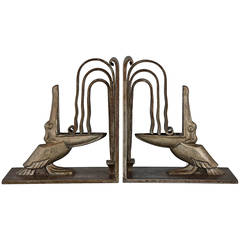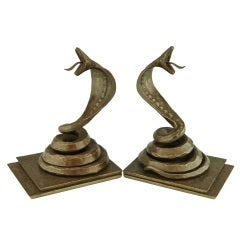Edgar Brandt Bookends
Recent Sales
Edgar Brandt Art Deco Pelican Bookends Wrought Iron, France, 1924
By Edgar Brandt
Located in Antwerp, BE
A pair of Art Deco wrought iron pelican bookends.
By Edgar Brandt.
Stamped E. Brandt.
Style
Category
Early 20th Century French Art Deco Bookends
Materials
Wrought Iron
Pair of Art Deco Wrought Iron Cobra Bookends by Edgar Brandt
By Edgar Brandt
Located in Antwerp, BE
A pair of Art Deco wrought iron cobra bookends by Edgar Brandt.
Fedex shipping: $ 125
Category
Vintage 1930s French Art Deco Bookends
Materials
Wrought Iron
Art Deco wrought iron wing bookends by Edgar Brandt France 1930
By Edgar Brandt
Located in Antwerp, BE
Art Deco wrought iron wing bookends by Edgar Brandt.
France 1930
These bookends are illustrated in
Category
Vintage 1930s French Art Deco Bookends
Materials
Iron, Wrought Iron
Art Deco Wing and Ball Wrought Iron Bookends Edgar Brandt, 1930
By Edgar Brandt
Located in Antwerp, BE
rectangular base by Edgar Brandt, France 1930.
“Edgar Brandt master of Art Deco ironwork” by Joan Kahr
Category
Vintage 1930s French Art Deco Bookends
Materials
Wrought Iron
Pair of Art Deco Wrought Iron Pelican Bookends by Edgar Brandt 1924 France
By Edgar Brandt
Located in Antwerp, BE
A fine pair of Art Deco pelican bookends, cast and wrought iron, signed by Edgar Brandt, France
Category
Vintage 1920s French Art Deco Bookends
Materials
Wrought Iron
H 6.7 in W 6.11 in D 2.96 in
Edgar Brandt Art Deco Pair of Wrought Iron Rooster Bookends
By Edgar Brandt
Located in Buenos Aires, Olivos
French Art Deco pair of wrought iron rooster bookends
by Edgar Brandt (1880-1960),
France, circa
Category
Vintage 1920s French Art Deco Bookends
Materials
Iron
Art Deco wrought iron pelican bookends by Edgar Brandt France 1924.
By Edgar Brandt
Located in Antwerp, BE
Art Deco wrought iron pelican bookends by Edgar Brandt, France 1924.
Cast & wrought iron, original
Category
Vintage 1920s French Art Deco Bookends
Materials
Wrought Iron
Art Deco Wrought Iron Bookends with Pelican Motif by Edgar Brandt
By Edgar Brandt
Located in Vienna, AT
For sale is a unique pair of Art Deco bookends by Edgar Brandt (1880-1960). They are wrought iron
Category
Early 20th Century French Art Deco Bookends
Materials
Wrought Iron
Bookends French Art Deco Carved Wood Floral Blossoms Antique Vintage
By Edgar Brandt
Located in Bad Säckingen, DE
Highly decorative French Art Deco bookends with an artistic touch for your bookshelf or desk. They
Category
Vintage 1920s French Art Deco Bookends
Materials
Brass
Pair of Art Deco Wrought Iron Pelican Bookends by Edgar Brandt
By Edgar Brandt
Located in Saint-Ouen, FR
A pair of Art Deco wrought iron Pelican bookends by Edgar Brandt,
circa 1929-1931.
Stamped E
Category
Vintage 1920s French Art Deco Bookends
Materials
Wrought Iron
Art Deco Pair of Wrought Iron Wing and Ball Bookends by Edgar Brandt
By Edgar Brandt
Located in New York, NY
. BRANDT
*Variety of other Brandt wrought iron bookends available.
Category
Vintage 1930s French Art Deco Bookends
Materials
Wrought Iron
Edgar Brandt Art Deco Wrought Iron Bookends
Located in New York, NY
Excellent example of winged ball bookends by master ironsmith Edgar Brandt. Signature stamped on
Category
Vintage 1930s French Decorative Objects
Pelican Bookends
By Edgar Brandt
Located in London, GB
A handsome pair of stylized Art Deco cast iron bookends in the form of two pelicans with bowls in
Category
Early 20th Century Art Deco Bookends
Materials
Iron
Get Updated with New Arrivals
Save "Edgar Brandt Bookends", and we’ll notify you when there are new listings in this category.
More Ways To Browse
Farnsworth Modern
Feltman Langer
Fencing Sword
Ferdinando Pogliani
Ferrari Sign
Ferrer Bronze
Fertility Vase
Field And Stream Vintage
Fifth Avenue Crystal
Fifties Sixties Seventies
Figural Ice Bucket
Figures Of Christ
Filippo Alison
Finn Juhl 138
Finn Juhl Bwana Chair
Finn Juhl Bwana
Finn Juhl Model 138
Finn Juhl Nv45

